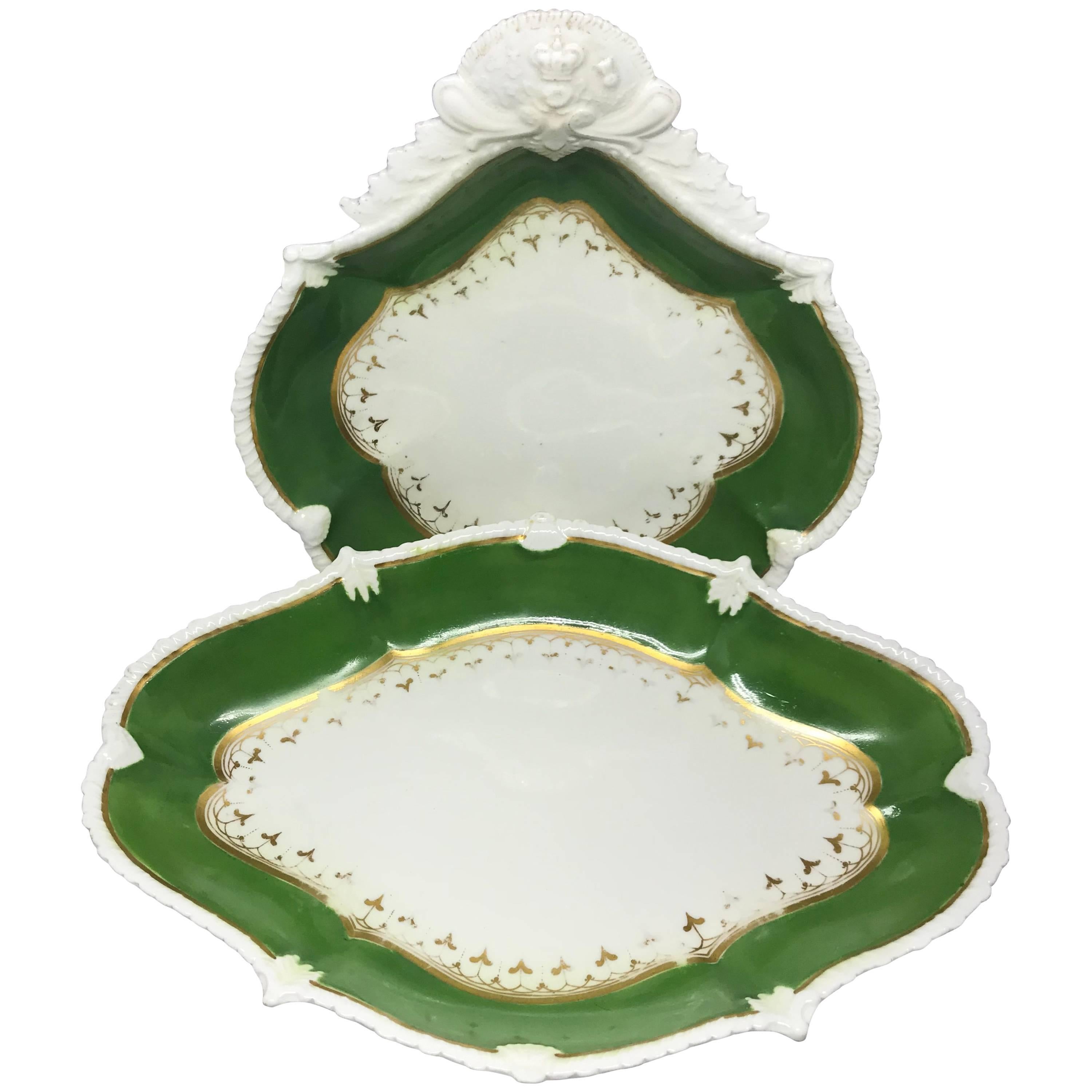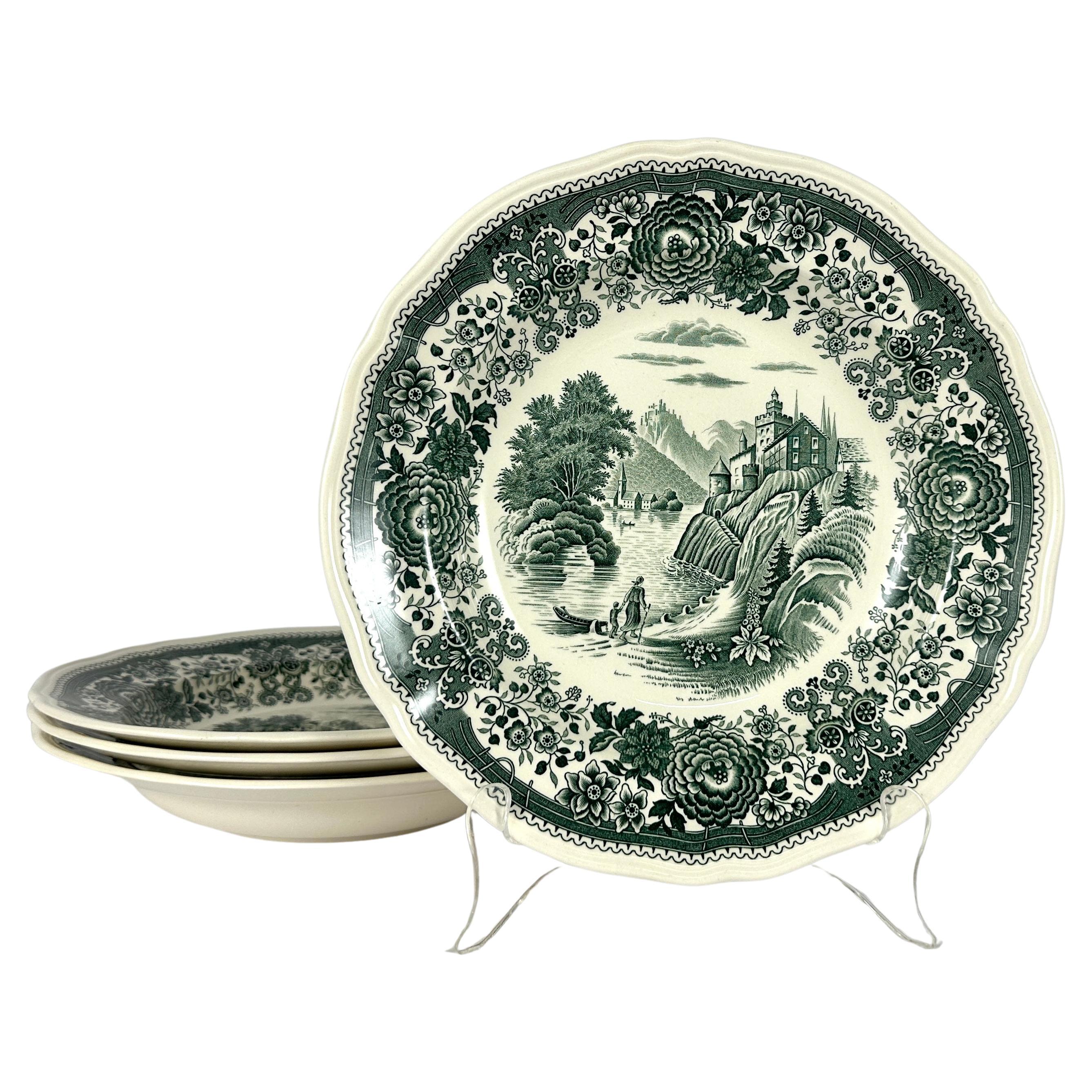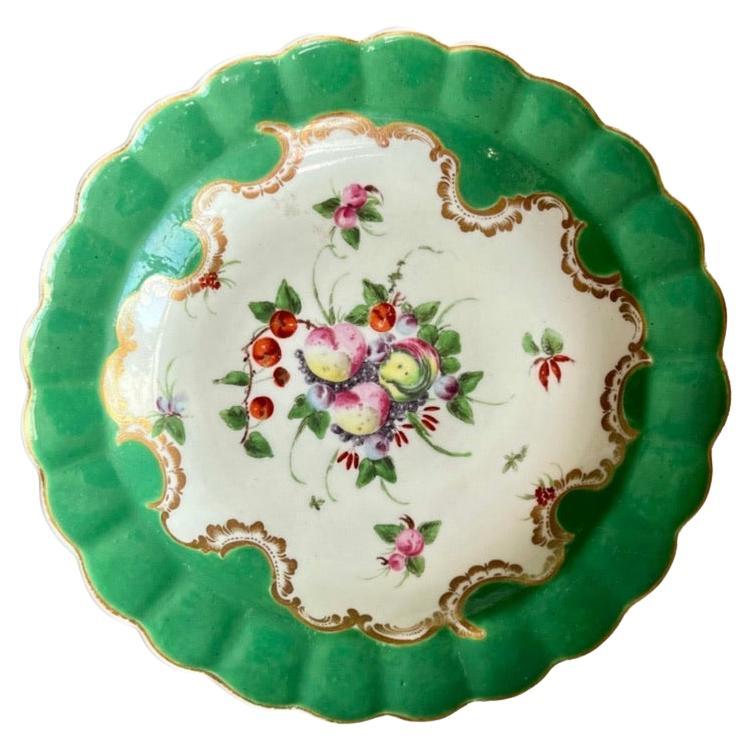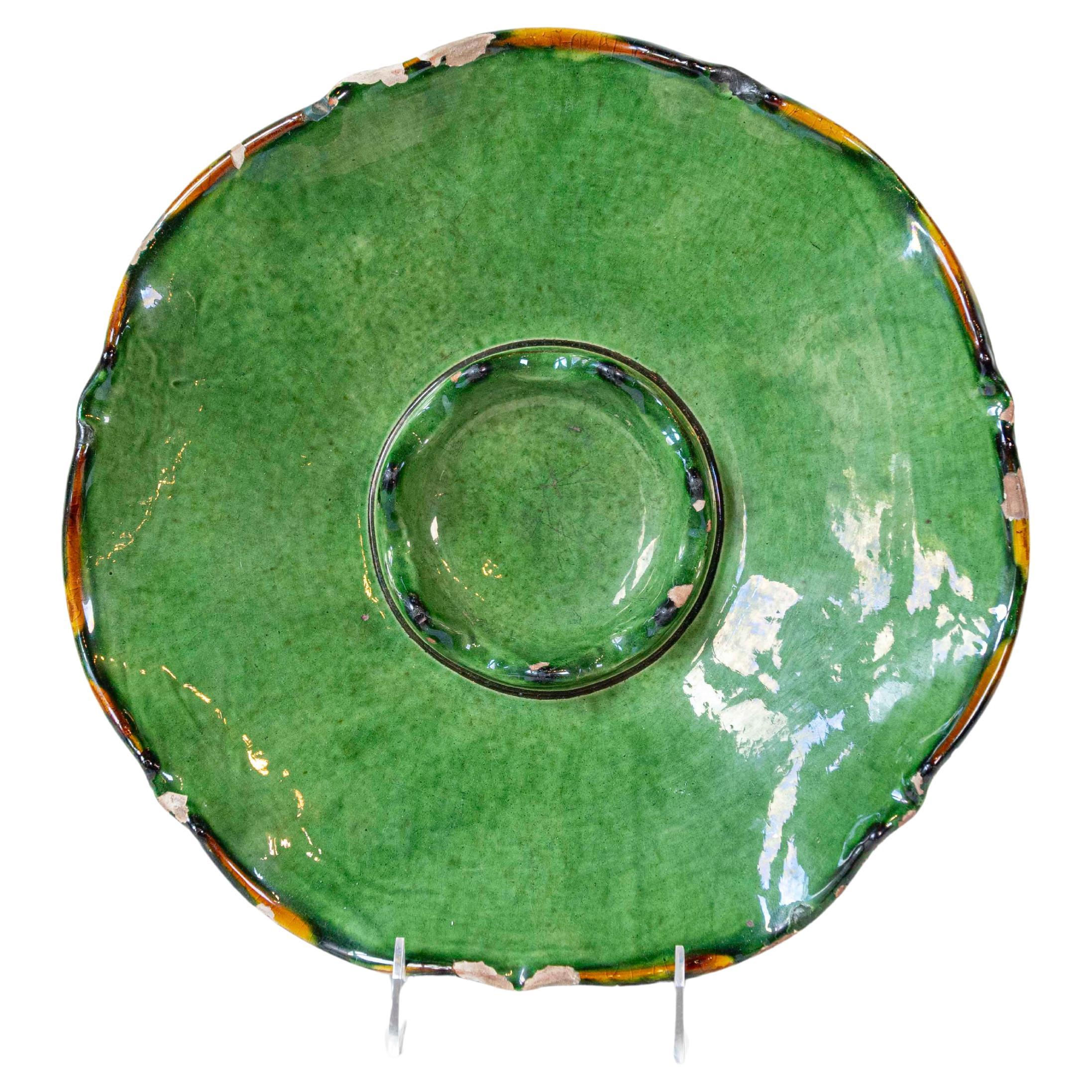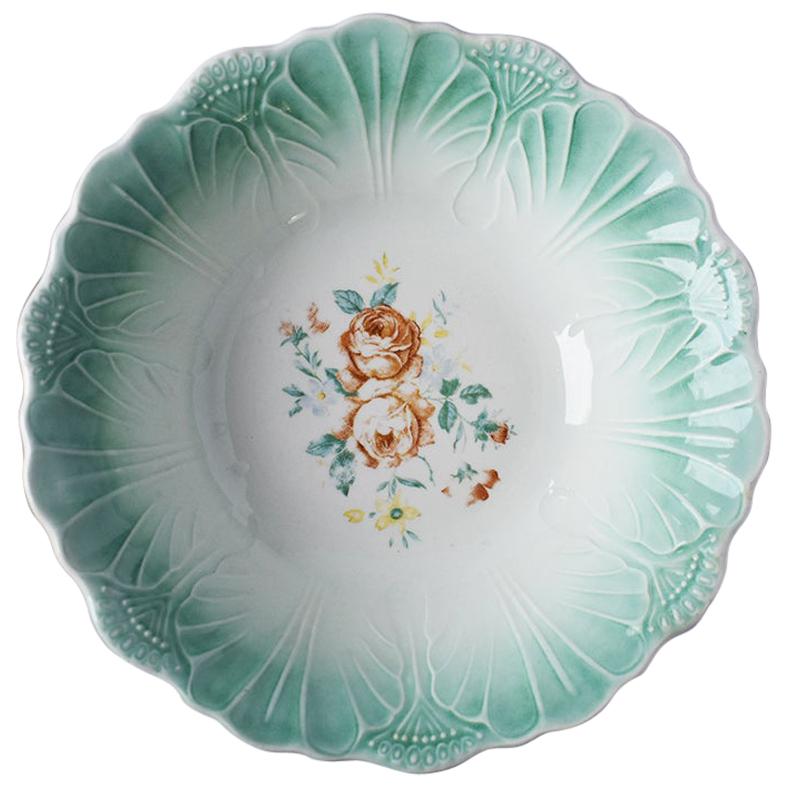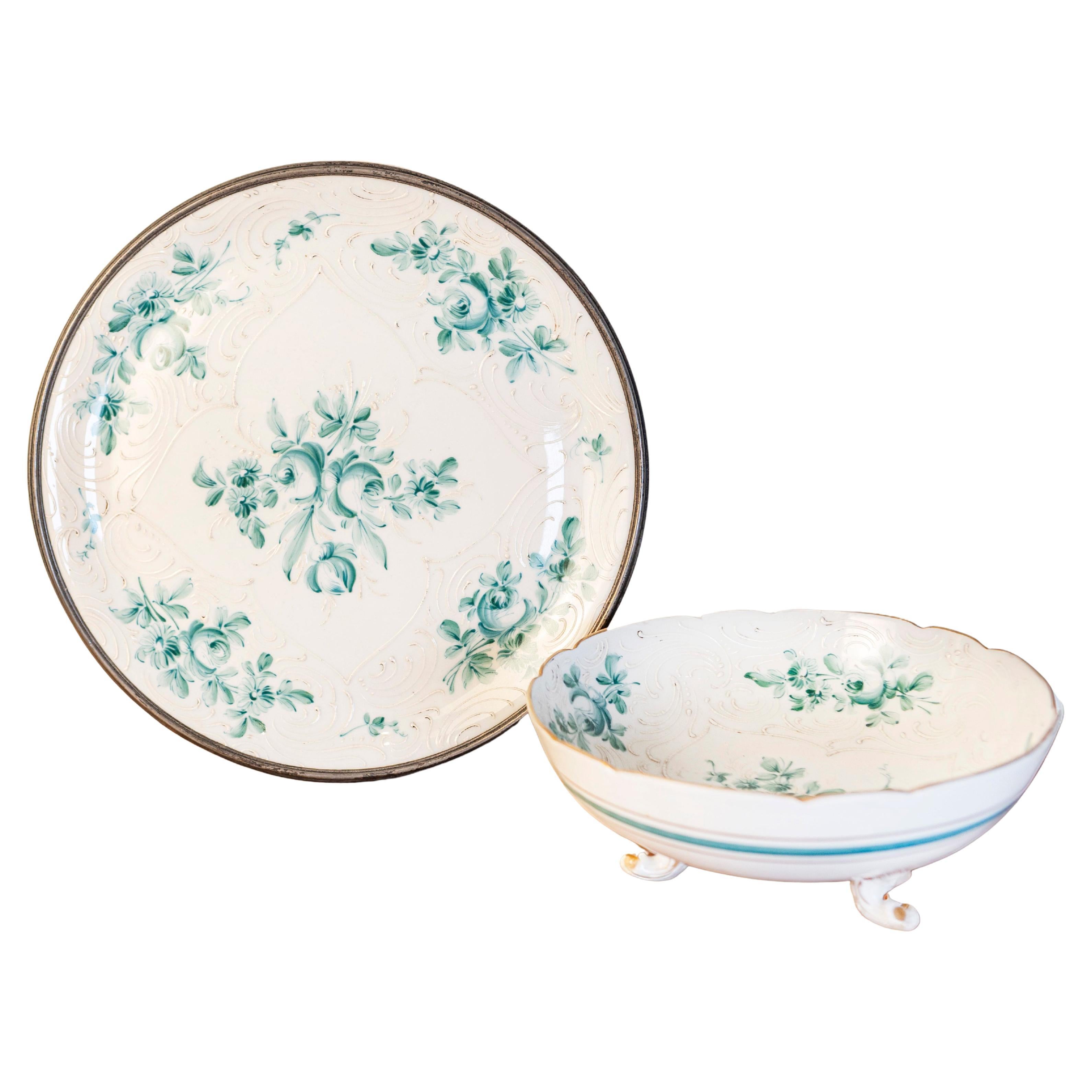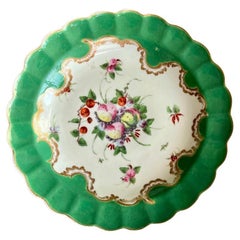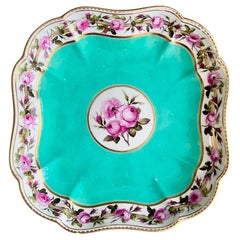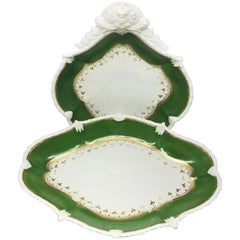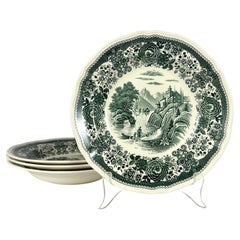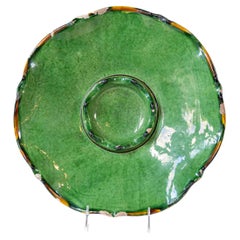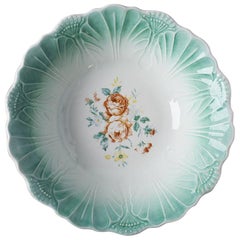Items Similar to Samuel Alcock Low Oval Comport Dish, Sage Green with Landscape, ca 1850
Want more images or videos?
Request additional images or videos from the seller
1 of 14
Samuel Alcock Low Oval Comport Dish, Sage Green with Landscape, ca 1850
$600
$75020% Off
£455.51
£569.3920% Off
€521.01
€651.2620% Off
CA$838.29
CA$1,047.8620% Off
A$932.36
A$1,165.4520% Off
CHF 486.85
CHF 608.5620% Off
MX$11,345.81
MX$14,182.2620% Off
NOK 6,217.80
NOK 7,772.2520% Off
SEK 5,831.20
SEK 7,28920% Off
DKK 3,888.47
DKK 4,860.5820% Off
Shipping
Retrieving quote...The 1stDibs Promise:
Authenticity Guarantee,
Money-Back Guarantee,
24-Hour Cancellation
About the Item
An oval low-footed comport with two handles and an octagonally scrolled shape, a moulded surface with pale yellow and white scrolling foliage on a sage green ground, and a stunning landscape in the centre of a ruin with two visitors
Pattern possibly 3/4434
Year: ca 1850
Size: 27cm X 22cm (10.5” X 8.5”)
Condition: light wear
The Samuel Alcock factory was operative in Staffordshire between 1822 and 1856, after which it was bought by Sir James Duke and Nephews. The factory started as a partnership between the young Samuel Alcock and the older Ralph Stevenson, who provided the factory and capital. Alcock quickly took the factory to great heights, building one of the biggest factories of its time. Alcock jumped on the new Rococo Revival fashion and served a huge new middle class market. The reason we now don't hear much about Samuel Alcock porcelain is that much of it has been mis-identified over the years and attributed to Coalport, Ridgway, Rockingham or others; Alcock did not mark any of his porcelain save a few rare pieces, and the numbering system is difficult to understand. However, the wares are still wide spread and many are of great quality.
This dish forms part of the Murray Pollinger Collection of Samuel Alcock Porcelain.
Murray Pollinger was a passionate collector of Samuel Alcock porcelain. He was known as a true gentleman, impeccably dressed, always kind and modest - even some of his porcelain collecting friends had no idea about the size and importance of his collection. From the mid 1980s until shortly before his death in 2022 he collected many thousands of pieces and painstakingly catalogued them. He also went on trips to Staffordshire to discover the history of Samuel Alcock from whatever little documentation has been preserved. Through his painstaking work, Pollinger was able to make sense of the pattern numbering system that was used, and this was a huge step forward in identifying and understanding the porcelain. A website with the results of his research will be made available over the course of 2023. While he sold off about half of his collection in 2016, the remaining half is now made available to a new generation of collectors.
Antique British porcelain is never perfect. Kilns were fired on coal in the 1800s, and this meant that china from that period can have some firing specks from flying particles. British makers were also known for their experimentation, and sometimes this resulted in technically imperfect results. Due to the shrinkage in the kiln, items can have small firing lines or develop crazing over time, which should not be seen as damage but as an imperfection of the maker's recipes, probably unknown at the time of making. Items have often been used for many years and can have normal signs of wear, and gilt can have signs of slight disintegration even if never handled. I will reflect any damage, repairs, obvious stress marks, crazing or heavy wear in the item description but some minor scratches, nicks, stains and gilt disintegration can be normal for vintage items and need to be taken into account.
There is widespread confusion on the internet about the difference between chips and nicks, or hairlines and cracks. I will reflect any damage as truthfully as I can, i.e. a nick is a tiny bit of damage smaller than 1mm and a chip is something you can easily see with the eye; a glazing line is a break in the glazing only; hairline is extremely tight and/or superficial and not picked up by the finger; and a crack is obvious both to the eye and the finger. Etcetera - I try to be as accurate as I can and please feel free to ask questions or request more detailed pictures!
- Creator:Samuel Alcock & Co. (Maker)
- Dimensions:Height: 2 in (5.08 cm)Width: 10.5 in (26.67 cm)Depth: 8.5 in (21.59 cm)
- Style:Victorian (Of the Period)
- Materials and Techniques:
- Place of Origin:
- Period:
- Date of Manufacture:circa 1850
- Condition:Wear consistent with age and use. excellent, light wear.
- Seller Location:London, GB
- Reference Number:Seller: MP-ALC411stDibs: LU4805137165292
About the Seller
5.0
Gold Seller
Premium sellers maintaining a 4.3+ rating and 24-hour response times
Established in 2016
1stDibs seller since 2019
225 sales on 1stDibs
- ShippingRetrieving quote...Shipping from: London, United Kingdom
- Return Policy
Authenticity Guarantee
In the unlikely event there’s an issue with an item’s authenticity, contact us within 1 year for a full refund. DetailsMoney-Back Guarantee
If your item is not as described, is damaged in transit, or does not arrive, contact us within 7 days for a full refund. Details24-Hour Cancellation
You have a 24-hour grace period in which to reconsider your purchase, with no questions asked.Vetted Professional Sellers
Our world-class sellers must adhere to strict standards for service and quality, maintaining the integrity of our listings.Price-Match Guarantee
If you find that a seller listed the same item for a lower price elsewhere, we’ll match it.Trusted Global Delivery
Our best-in-class carrier network provides specialized shipping options worldwide, including custom delivery.More From This Seller
View AllWorcester Small Lobed Dish, Apple Green, Spotted Fruit James Giles, ca 1770
By James Giles, 1st Period Worcester Dr. Wall
Located in London, GB
This is a beautiful small deep plate made by Worcester in about 1770 in their First or the "Dr Wall" period. It is a small, lobed dish with a deep green ground, elegant tooled gildin...
Category
Antique 1770s English George III Porcelain
Materials
Porcelain
Derby Lobed Dish, Camden Service, William Billingsley Roses on Green, 1795 (1)
By Derby
Located in London, GB
This is a very rare oval lobed dish from the famous "Earl of Camden" service made by the Derby Porcelain Company in 1795. The service was painted with typical English roses by William Billingsley, one of Britain's most famous painters, and responsible for exactly this type of rose painting on British porcelain.
There are more items available in this pattern, see separate listings. To keep these items together we'd be happy to offer a discount on multiple purchases - please ask!
The Derby Porcelain Company, later called Royal Crown Derby, is currently the oldest British porcelain factory still in production. The Derby pottery was one of the most prominent potteries right from the start of English porcelain production in the mid 1700s to today, and the factory went through many iterations. In the 1820s, it was called "Bloor Derby" as it came under the ownership of Robert Bloor; this factory later closed but its legacy was continued under the ownership of a group of employees, and later this was merged into a new factory called Royal Crown Derby, which is still in operation today and still carries forward some of the oldest patterns that have made it famous over the centuries.
William Billingsley was a brilliant but notoriously difficult man who left behind a trail of debts, broken hearts and mystery - but he was also one of the most important people in the history British porcelain. Billingsley revolutionised the way British decorators painted flowers; he added a freedom and artistry that now singles out British flower painting, and he created a new technique for painting roses, which you can see in this design. Billingsley worked at Derby, Worcester and Mansfield. He also set up his own potteries in Pinxton and Nantgarw and created some of the best porcelain ever made, but racking up great debts, before running off in the dead of night and ending his days at Coalport painting flowers.
Items painted by William Billingsley are rare and very much in demand - together with Thomas Baxter's work they are probably among the most desired pieces of British porcelain.
The Earl of Camden service was a huge service ordered by Lady Camden in 1795. It had to be produced under great, and unrealistic, time pressure and was notoriously late, much to Lady Camden's chagrin. She wanted the service to be produced by only the best artisans and therefore William Billingsley was tasked with painting all items - but it is thought that when it was clear the deadline was impossible to make, he enlisted the help of John Brewer for some of the last items, such as the ice pails. This plate shows the typical "Billingsley" roses: a beautiful naturally flowing garland of English roses interspersed with buds, trailing around a crisp gilt ribbon. The way the roses link into each other, the way each individual one is completely different, the light effects achieved by rubbing out some of the pink paint, and the very fine buds and foliage all point to these being from Billingsley's hand.
This dish came together with a plate that bears labels that point to a rich provenance: the Doris Wheatley Collection, the Daniel Collection, Derek Gardner...
Category
Antique 1790s English George III Serving Bowls
Materials
Porcelain
Derby Oval Dish, Camden Service, William Billingsley Roses on Green, 1795 (2)
By Derby
Located in London, GB
This is a very rare oval lobed dish from the famous "Earl of Camden" service made by the Derby Porcelain Company in 1795. The service was painted with typical English roses by William Billingsley, one of Britain's most famous painters, and responsible for exactly this type of rose painting on British porcelain.
There are more items available in this pattern, see separate listings. To keep these items together we'd be happy to offer a discount on multiple purchases - please ask!
The Derby Porcelain Company, later called Royal Crown Derby, is currently the oldest British porcelain factory still in production. The Derby pottery was one of the most prominent potteries right from the start of English porcelain production in the mid 1700s to today, and the factory went through many iterations. In the 1820s, it was called "Bloor Derby" as it came under the ownership of Robert Bloor; this factory later closed but its legacy was continued under the ownership of a group of employees, and later this was merged into a new factory called Royal Crown Derby, which is still in operation today and still carries forward some of the oldest patterns that have made it famous over the centuries.
William Billingsley was a brilliant but notoriously difficult man who left behind a trail of debts, broken hearts and mystery - but he was also one of the most important people in the history British porcelain. Billingsley revolutionised the way British decorators painted flowers; he added a freedom and artistry that now singles out British flower painting, and he created a new technique for painting roses, which you can see in this design. Billingsley worked at Derby, Worcester and Mansfield. He also set up his own potteries in Pinxton and Nantgarw and created some of the best porcelain ever made, but racking up great debts, before running off in the dead of night and ending his days at Coalport painting flowers.
Items painted by William Billingsley are rare and very much in demand - together with Thomas Baxter's work they are probably among the most desired pieces of British porcelain.
The Earl of Camden service was a huge service ordered by Lady Camden in 1795. It had to be produced under great, and unrealistic, time pressure and was notoriously late, much to Lady Camden's chagrin. She wanted the service to be produced by only the best artisans and therefore William Billingsley was tasked with painting all items - but it is thought that when it was clear the deadline was impossible to make, he enlisted the help of John Brewer for some of the last items, such as the ice pails. This plate shows the typical "Billingsley" roses: a beautiful naturally flowing garland of English roses interspersed with buds, trailing around a crisp gilt ribbon. The way the roses link into each other, the way each individual one is completely different, the light effects achieved by rubbing out some of the pink paint, and the very fine buds and foliage all point to these being from Billingsley's hand.
This dish came together with a plate that bears labels that point to a rich provenance: the Doris Wheatley Collection, the Daniel Collection, Derek Gardner...
Category
Antique 1790s English George III Serving Bowls
Materials
Porcelain
Derby Square Dish, Camden Service, William Billingsley Roses on Green, 1795
By Derby
Located in London, GB
This is a very rare square dish from the famous "Earl of Camden" service made by the Derby Porcelain Company in 1795. The service was painted with typical English roses by William Billingsley, one of Britain's most famous painters, and responsible for exactly this type of rose painting on British porcelain.
There are more items available in this pattern, see separate listings. To keep these items together we'd be happy to offer a discount on multiple purchases - please ask!
The Derby Porcelain Company, later called Royal Crown Derby, is currently the oldest British porcelain factory still in production. The Derby pottery was one of the most prominent potteries right from the start of English porcelain production in the mid 1700s to today, and the factory went through many iterations. In the 1820s, it was called "Bloor Derby" as it came under the ownership of Robert Bloor; this factory later closed but its legacy was continued under the ownership of a group of employees, and later this was merged into a new factory called Royal Crown Derby, which is still in operation today and still carries forward some of the oldest patterns that have made it famous over the centuries.
William Billingsley was a brilliant but notoriously difficult man who left behind a trail of debts, broken hearts and mystery - but he was also one of the most important people in the history British porcelain. Billingsley revolutionised the way British decorators painted flowers; he added a freedom and artistry that now singles out British flower painting, and he created a new technique for painting roses, which you can see in this design. Billingsley worked at Derby, Worcester and Mansfield. He also set up his own potteries in Pinxton and Nantgarw and created some of the best porcelain ever made, but racking up great debts, before running off in the dead of night and ending his days at Coalport painting flowers.
Items painted by William Billingsley are rare and very much in demand - together with Thomas Baxter's work they are probably among the most desired pieces of British porcelain.
The Earl of Camden service was a huge service ordered by Lady Camden in 1795. It had to be produced under great, and unrealistic, time pressure and was notoriously late, much to Lady Camden's chagrin. She wanted the service to be produced by only the best artisans and therefore William Billingsley was tasked with painting all items - but it is thought that when it was clear the deadline was impossible to make, he enlisted the help of John Brewer for some of the last items, such as the ice pails. This plate shows the typical "Billingsley" roses: a beautiful naturally flowing garland of English roses interspersed with buds, trailing around a crisp gilt ribbon. The way the roses link into each other, the way each individual one is completely different, the light effects achieved by rubbing out some of the pink paint, and the very fine buds and foliage all point to these being from Billingsley's hand.
This dish came together with a plate that bears labels that point to a rich provenance: the Doris Wheatley Collection, the Daniel Collection, Derek Gardner...
Category
Antique 1790s English George III Serving Bowls
Materials
Porcelain
Samuel Alcock Pair of Low Comports, Grey, Gilt with Landscapes, Flowers, ca 1859
By Samuel Alcock & Co.
Located in London, GB
This is a rather stunning pair of one-handled low comports with pierced rims, a warm grey ground with elaborate gilt foliage, three very fine flower reserves each, and a large mounta...
Category
Antique 1850s English Rococo Revival Porcelain
Materials
Porcelain
$792 Sale Price / set
20% Off
Free Shipping
Bloor Derby Shell Dish, White, Floral Sprigs Moses Webster, Regency, 1820-1825
By Bloor Derby
Located in London, GB
This is a beautiful one-handled dessert serving dish or "shell" dish made by Derby between about 1820 and 1825 in the Regency era and decorated by Moses Webster. These dishes were to...
Category
Antique 1820s English Regency Serving Bowls
Materials
Porcelain
$460 Sale Price
20% Off
Free Shipping
You May Also Like
Set of English Green and Gilt Banded Serving Dishes
Located in New York, NY
Set of English green and gilt banded serving dishes Scallop edged oval dish and shell form shaped sweetmeat dish with Scottish crowned thistle; both with gilt border.
Dimensions: Ov...
Category
Antique 19th Century English Serving Bowls
Materials
Porcelain
Villeroy & Boch Burgenland Soup Pasta Plates Green Rimmed Soup Bowl Salad Plate
By Villeroy & Boch
Located in Bastogne, BE
Villeroy & Boch, Germany, deep soup/pasta plates in Green Burgenland Pattern.
Mettlach ceramics from Germany.
This is a discontinued pattern, having been retired in 2002.
The Burg...
Category
Vintage 1970s German Romantic Soup Tureens
Materials
Porcelain
French Provincial 1850s Green Glazed Hors d'Œuvres Dish with Scalloped Edges
Located in Atlanta, GA
A French Provincial green glazed pottery Hors d'Œuvres dish from the mid 19th century, with scalloped edges and orange accents. Created in Provence during the reign of Emperor Napolé...
Category
Antique Mid-19th Century French French Provincial Serving Pieces
Materials
Pottery
Round Green Ceramic Cabbage Leaf Serving Bowl with Floral Pattern
Located in Oklahoma City, OK
Round green and white cabbage serving dish with floral motif. A lovely way to add a touch of spring to any table! This dish has scalloped edges, with mint green ombre which moves int...
Category
Early 20th Century North American Art Nouveau Ceramics
Materials
Ceramic
$200 Sale Price
20% Off
French Limoges Porcelain Bowl with Green Bouquet of Roses and Underplate
By Limoges
Located in Atlanta, GA
A French Limoges porcelain bowl from the late 19th century, with green bouquet of roses décor, petite gilt feet and matching underplate. Created by the AMR factory (Ancienne Manufact...
Category
Antique 19th Century French Napoleon III Serving Bowls
Materials
Porcelain
Antique 18th Century Dutch Delft or Samadet Green Faience Barber's Bowl
By Delft
Located in Bad Säckingen, DE
This exquisite 18th-century Dutch Delft or Samadet faience barber's bowl showcases a classic lobed shape with a notched rim, traditionally designed for shaving use. The piece is hand-painted in vibrant green with a central floral motif surrounded by delicate foliate designs, accentuated by a decorative border along the scalloped edge. The tin-glazed ceramic surface exhibits the characteristic craquelure and slight imperfections typical of early Delftware.
Originally used in barbershops for lathering and rinsing during shaves, this historical faience bowl is now a highly collectible decorative object, perfect for display in a Delftware collection or as a charming accent in a period interior.
A remarkable example of Dutch craftsmanship, this piece captures the elegance and functionality of antique Delftware.
Category
Antique Early 18th Century Dutch Baroque Decorative Bowls
Materials
Faience
More Ways To Browse
Kiln Formed Glass
Stained Glass Dress
Stained Glass Oval
Victorian China Porcelain
Coalport Hand Painted
Chinese Landscape Scroll
Etcetera Etcetera
Finger Bowls
Antique Coalport Patterns
Ridgway England
Antique Comport
Chinese Footed Dish
Silver Comport
Antique Ridgway Porcelain
Coalport China
Coalport Chinese Porcelain
Ridgway Staffordshire
Antique Rockingham
